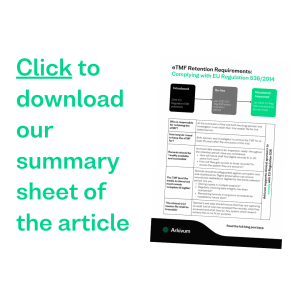eTMF retention requirements: complying with EU Regulation 536/2014
eTMF retention requirements: complying with EU Regulation 536/2014
As we approach the one-year anniversary of EU Regulation 536/2014 coming into effect, I thought it would be a good opportunity to review the retention requirements from a long-term data management perspective.
In this post, I will highlight the key elements of the regulation that relate to data retention, and outline what these mean through the lens of digital archiving and preservation.
It’s also worth mentioning that I’m going to interchange between trial master file, TMF and eTMF throughout the post. If you’d like more information on what this is, you can read our recent post on ‘What is the Trial Master File (TMF)?’.
So here goes…
Who is responsible for retaining the eTMF?
The sponsor and the investigator shall keep a clinical trial master file. – EU Regulation 536/2014, Article 57 Clinical trial master file
This is a relatively easy one for us to start with, but it’s important to clarify in the context of retention. At the conclusion of the trial both the drug sponsor and investigator must retain their trial master file for the stated period (see below).
It’s worth noting that these two sets of documents may not necessarily be the same for the same trial, given the different set of responsibilities for the two parties.
How long do I need to keep the eTMF for?
Unless other Union law requires archiving for a longer period, the sponsor and the investigator shall archive the content of the clinical trial master file for at least 25 years after the end of the clinical trial. – EU Regulation 536/2014, Article 58 Clinical trial master file
A major change to come into effect with the new regulation was the requirement for both sponsor and investigator to archive the TMF for at least 25 years after the conclusion of the trial.
While this may sound simple, in practice this creates several challenging operational hurdles to overcome. We’ll explore these in more detail in the next sections.
A readily available and accessible archive
The content of the clinical trial master file shall be archived in a way that ensures that it is readily available and accessible, upon request, to the competent authorities. – EU Regulation 536/2014, Article 58 Clinical trial master file
The first operational challenge comes in the form of ensuring that any records, or in the case of an eTMF, digital records must be both available and accessible for the entire retention period.
Before the shift to eTMFs, this would simply have been a case of storing the physical documents within an appropriate bricks and mortar archive. Retaining digital records requires a different approach.
To give just a couple of examples of things to consider:
- How will individuals responsible* for the archive find content in 25 years’ time, for example during an inspection? It’s unlikely that these individuals would be the same as those originally involved. Attributing appropriate metadata (or data about each record – think ‘Date Created’ as a very basic example) can be one way to ensure records can be easily found.
- How easy will it be to gain access to the records in the future? If they are being stored on physical media such as an external hard drive (not that this is recognised good practice**), how would you access that technology 5, 10 or even 20 years from now? Where would it even be stored?
- If they’re being stored within an eTMF solution, how easy will it be to access that system over that same period of time?
This extract from the regulation is simply stating that your archived data needs to be ‘inspection-ready’ throughout the retention period. The data needs to be stored somewhere that you can order, control and manage to guarantee that it is always accessible if required.
Preserving the eTMF
The media used to archive the content of the clinical trial master file shall be such that the content remains complete and legible throughout the period referred to in the first paragraph. – EU Regulation 536/2014, Article 58 Clinical trial master file
As with ensuring availability and accessibility of the eTMF throughout the retention period, data legibility sounds simple, but is far from it.
The first challenge is ensuring that the method used to archive the data will remain intact and free from corruption or failure throughout the period. In the example above of the external hard drive, these devices have an average shelf life of roughly 3 to 5 years before some component will likely fail.
The second challenge is planning to regularly check that data hasn’t become corrupted overtime. Unfortunately, this is an unavoidable risk with any data that is being retained, and so appropriate plans must be put in place to ensure regular checking of the integrity of each record.
Even if a risk based approach to TMF management looks at only 10% of your documents, manual checking of these files would be a significant investment in time and effort. A dedicated archive will safeguard against corruption by conducting automated integrity checks on all the files, and resolve any issues identified.
The Arkivum system would handle this by replicating a ‘good’ version of the record from a secondary location – it is one reason why storing multiple copies is crucial for any effective long-term strategy.
In the Arkivum system, for example, multiple copies of the data are stored in different locations. Automated checksums are used to assert and monitor data integrity. If corruption is detected in one of the copies, then one of the other known good copies can be used to replace the corrupted copy. This protects against a wide range of data corruption scenarios and can be used to prove that the content of archived files has not be altered or corrupted over time.
A final challenge comes in the form of opening and reading any saved documents. Over the next 25 years, technology will change beyond what I can predict today. Accessing an eTMF created today, with a device used 20 years from now will likely result in either a ‘File not recognised’ or ‘This device cannot open this file’.
A digital preservation solution will ensure that files are maintained in preservation formats (in addition to the original version) to guarantee that records will be legible throughout the entire retention period.
Capturing an audit trail
Any alteration to the content of the clinical trial master file shall be traceable. – EU Regulation 536/2014, Article 58 Clinical trial master file
The final part of the regulation that I want to highlight is the capturing of audit trails within your archive. Audit trails can and arguably should not only capture, as referenced above, any changes to the documents, but also who has accessed what and when.
This is also linked to another part of Article 58, which I haven’t referenced, that access to the archives should be closely controlled, with access only granted to those responsible for the archive (and inspectors in the case of an inspection!).
Any digital system which cannot capture an audit trail is not fit for purpose for retaining the eTMF.
In summary
Articles 57 and 58 of EU Regulation 536/2014 total just over 300 words and yet the requirements outlined within these sections create several operational challenges that sponsors and investigators have not had to address previously.
I hope that this article has provided some insight into not only what these requirements mean, but how sponsors and investigators can start to prepare their long-term retention strategies.
This year, Arkivum published an updated version of our eTMF archiving and preservation eBook which provides more detail on these topics. You can access this here.
Alternatively, I’d be delighted to talk to you further about anything I’ve raised in this article. You can contact me via the Contact page on the website.
*An additional part of the regulation (also within Article 58) states that an individual (or individuals) should be made responsible for the archive and access should be granted only to them.
**It’s not recognised good practice to use external hard drives or USB sticks for long-term storage, but sometimes this is considered by archives because it allows familiar ‘paper-based’ archiving processes to be followed. Offline physical media does create multiple challenges, including: (a) risk of failures, (b) difficult to retrieve data in the future, e.g. for inspections, (c) can be easy to misplace or hard to find in the future.

Tom Lynam
Tom is the Marketing Director at Arkivum. He joined the business in January 2020 tasked with driving new business growth and building the brand into new sectors such as Pharmaceutical and Life Sciences. He has over 12 years’ experience in several diverse marketing leadership roles across technology and professional services organisations.
Get in touch
Interested in finding out more? Click the link below to arrange a time with one of our experienced team members.
Book a demo
